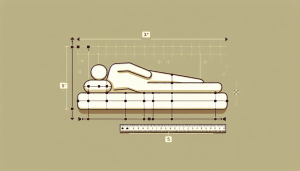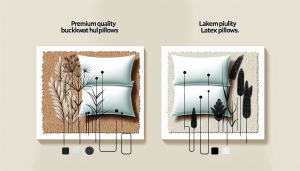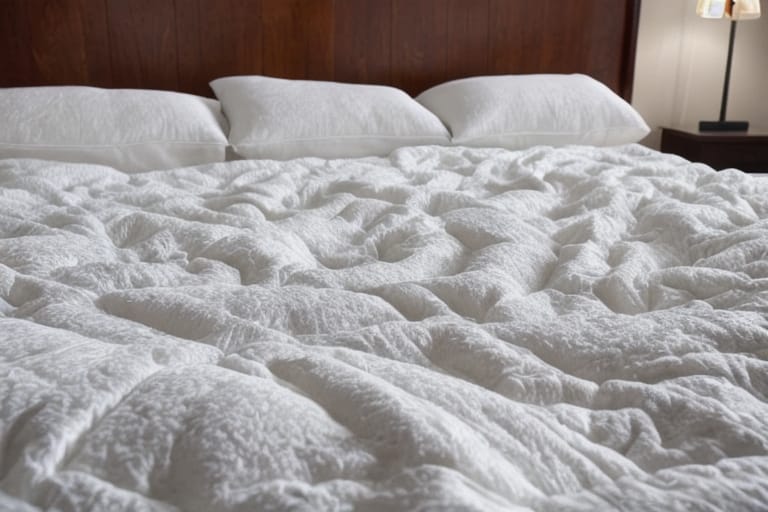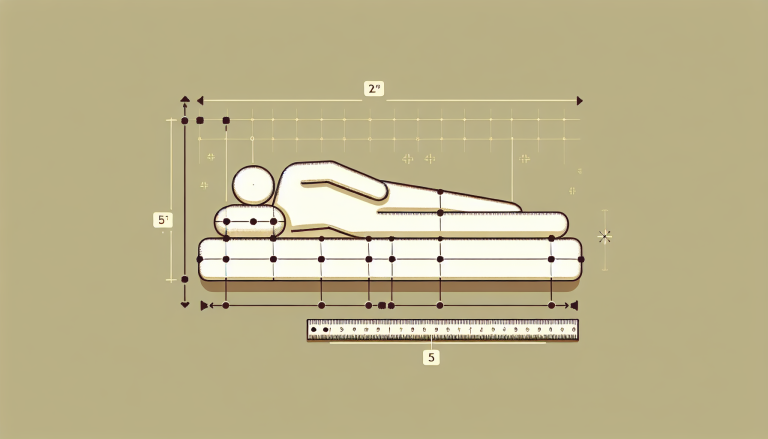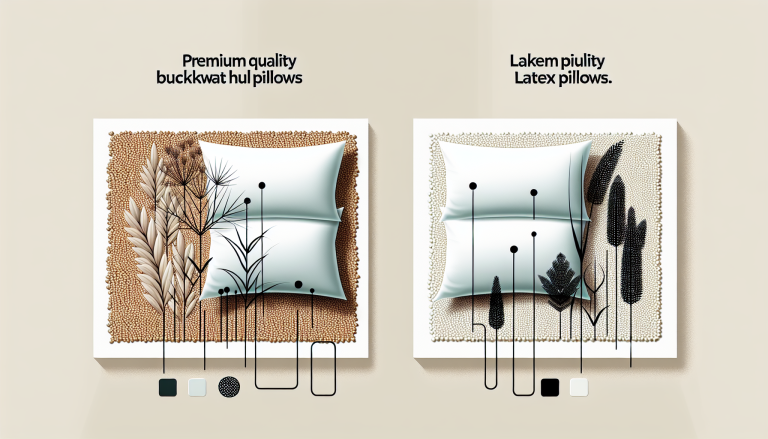Are you on the hunt for the perfect down comforter to keep you warm and cozy all night long? With so many options on the market, it can be overwhelming to know where to start. That’s why we’ve put together this comprehensive guide to help you understand everything you need to know about down comforters, from fill power and construction to ethical sourcing and care instructions. By the end, you’ll be equipped with the knowledge to find the best down comforter for your needs and budget.
Understanding Down Comforters
Before we dive into the best places to buy down comforters, let’s first understand what makes them so special.
What is Down?
Down refers to the soft, fluffy undercoating of waterfowl like geese and ducks. It’s incredibly lightweight and insulating, making it the perfect fill material for comforters.
There are two main types of down used in comforters: goose down and duck down. Goose down is generally considered to be of higher quality, as it has larger clusters and better loft. However, duck down can still provide excellent warmth and comfort at a lower price point.
Another important factor to consider is fill power, which measures the loft and insulating ability of the down. The higher the fill power, the warmer and fluffier the comforter will be. Look for comforters with a fill power of at least 600 for optimal warmth and comfort.
When shopping for down comforters, it’s also important to look for products that use ethically sourced down. The Responsible Down Standard (RDS) certifies that the down comes from ducks and geese that were treated humanely throughout their lives.
Comforter Construction
The way a down comforter is constructed can also impact its warmth, durability, and overall comfort. There are two main construction methods: baffle box and sewn-through.
Baffle box construction features vertical walls of fabric that separate the down filling into boxes, allowing it to loft fully and provide maximum insulation. This method is generally considered to be of higher quality, but also comes at a higher price point.
Sewn-through construction, on the other hand, features the top and bottom layers of the comforter sewn together directly, creating a thinner, more lightweight design. While not as warm as baffle box, sewn-through comforters are often more affordable and easier to clean.
The outer shell of the comforter is also important to consider. Look for comforters with a high thread count (at least 300) and a tightly woven cotton shell for optimal durability and softness.
Benefits of Down Comforters
So why choose a down comforter over other types of bedding? Here are just a few of the benefits:
- Breathability and Temperature Regulation: Down is naturally breathable and moisture-wicking, helping to regulate your body temperature throughout the night.
- Lightweight and Loft: Despite their incredible warmth, down comforters are surprisingly lightweight and fluffy, making them a joy to sleep under.
- Durability and Longevity: With proper care, a high-quality down comforter can last for many years, making it a worthwhile investment in your sleep health.
Factors to Consider When Buying a Down Comforter
Now that you have a basic understanding of down comforters, let’s explore some of the key factors to consider when making your purchase.
Warmth Needs
One of the most important factors to consider is your individual warmth needs. Are you a hot sleeper who tends to overheat at night, or do you need extra warmth to stay comfortable?
For cold sleepers, look for comforters with a higher fill power (700+) and a baffle box construction for maximum insulation. You may also want to consider a dual warmth comforter, which has different levels of fill on each side to accommodate couples with different temperature preferences.
If you tend to sleep hot, on the other hand, opt for a lightweight, all-season comforter with a lower fill power (600-700) and a sewn-through construction.
It’s also important to consider your climate and room temperature when selecting a comforter. If you live in a colder climate or keep your bedroom on the chilly side, you’ll likely need a warmer comforter than someone in a more temperate environment.
Size and Fit
Another key factor to consider is the size and fit of your comforter. Make sure to measure your bed and select a comforter that is appropriately sized, allowing for plenty of drape over the sides.
If you share a bed with a partner, you may want to consider an oversized comforter to ensure that you both have enough coverage. King and California King sizes are ideal for couples.
You’ll also need to decide between a duvet insert and a standalone comforter. Duvet inserts are designed to be used with a separate duvet cover, which can be easily removed for washing. Standalone comforters, on the other hand, have a built-in cover that is not removable.
If you opt for a duvet insert, consider investing in a custom duvet cover to perfectly match your bedroom decor.
Budget and Value
Down comforters can range in price from under $100 to over $1,000, depending on factors like fill power, construction, and brand. While it may be tempting to opt for the cheapest option, investing in a high-quality comforter can pay off in the long run in terms of durability and comfort.
That said, there are plenty of budget-friendly options that still offer excellent value. Look for comforters with a fill power of at least 600 and a solid construction, and be sure to read customer reviews to get a sense of the product’s quality and longevity.
Keep an eye out for sales and discounts, especially during major shopping holidays like Black Friday and Cyber Monday. Many retailers offer significant markdowns on down comforters during these times.
Top Down Comforter Brands
Now that you know what to look for in a down comforter, let’s explore some of the top brands on the market.
Brand Reputations
When shopping for a down comforter, it’s important to consider the reputation and history of the brand. Look for companies with a long track record of producing high-quality bedding and a commitment to customer satisfaction.
Some top brands to consider include:
- Brooklinen: Known for their high-quality, affordable bedding, Brooklinen offers a range of down comforters with fill powers ranging from 650 to 750.
- The Company Store: With over 100 years of experience in the bedding industry, The Company Store offers a wide range of down comforters at various price points.
- L.L.Bean: A trusted name in outdoor gear and home goods, L.L.Bean offers a selection of high-quality down comforters with a lifetime guarantee.
Be sure to read customer reviews and look for brands with solid warranties and return policies to ensure that you’re getting a product that will last.
Fill Types and Sources
As mentioned earlier, the type of down used in a comforter can impact its quality and warmth. Goose down is generally considered to be of higher quality than duck down, but both can provide excellent insulation and comfort.
When shopping for a down comforter, look for products that use responsibly sourced down from suppliers that adhere to strict animal welfare standards. The Responsible Down Standard (RDS) and the Global Traceable Down Standard (TDS) are two certifications to look for.
If you have allergies or sensitivities, consider a comforter with hypoallergenic down that has been treated to reduce allergens and irritants.
Construction and Materials
The construction and materials used in a down comforter can also impact its quality and durability. Look for comforters with a high thread count (300+) and a tightly woven cotton shell for optimal softness and strength.
Baffle box construction is generally considered to be of higher quality than sewn-through, as it allows the down to loft fully and provide maximum insulation. However, sewn-through comforters can still be a good option for those on a budget or who prefer a lighter weight comforter.
Some down comforters also feature antimicrobial and moisture-wicking treatments to help keep them fresh and dry throughout the night.
Care and Maintenance
Proper care and maintenance are essential for keeping your down comforter in top condition for years to come. Here are some tips to keep in mind:
Washing and Drying
Most down comforters are machine washable, but it’s important to follow the manufacturer’s care instructions carefully. Use a mild detergent and wash on a gentle cycle with cold water.
If you have an oversized comforter, you may need to take it to a laundromat with commercial-sized washers to ensure that it has enough room to tumble and fluff.
After washing, dry your comforter on low heat with a few clean tennis balls or dryer balls to help restore its loft and fluffiness.
Storage and Rotation
When not in use, store your down comforter in a breathable storage bag to protect it from dust and moisture. Avoid compressing the comforter too tightly, as this can damage the down clusters and reduce its loft.
If you have multiple comforters, consider rotating them seasonally to help extend their lifespan and keep them fresh.
Extending Lifespan
With proper care, a high-quality down comforter can last for many years. To extend its lifespan, be sure to follow the manufacturer’s care instructions carefully and avoid harsh chemicals or excessive heat when washing and drying.
If you notice any rips or tears in the shell, repair them promptly to prevent the down from leaking out. Consider using a duvet cover to protect the comforter from stains and wear and tear.
If your comforter starts to lose its loft or warmth over time, it may be time to replace it. A good rule of thumb is to replace your comforter every 5-10 years, depending on usage and care.
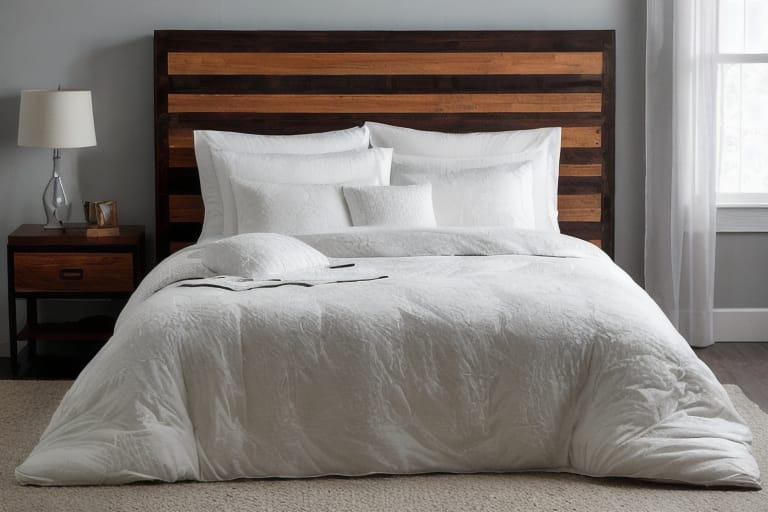
Sustainable and Eco-Friendly Options
If you’re looking for a down comforter that’s not only comfortable but also environmentally friendly, there are plenty of sustainable options on the market.
Recycled and Natural Materials
Some down comforters are made with recycled materials, such as recycled down or recycled polyester shells. These products help reduce waste and minimize the environmental impact of production.
Other comforters use natural materials like organic cotton, lyocell, or eucalyptus fibers for the shell, which are more sustainable and biodegradable than synthetic options.
Look for products with certifications like the Global Organic Textile Standard (GOTS) or the Oeko-Tex Standard 100, which ensure that the materials used are free from harmful chemicals and produced in an environmentally and socially responsible way.
Energy Efficiency
Down comforters are naturally insulating, which can help reduce your energy usage and heating costs during colder months. Look for comforters with a high fill power and a baffle box construction for maximum insulation and energy efficiency.
By choosing a down comforter over a synthetic alternative, you can also reduce your carbon footprint, as down is a natural and biodegradable material.
Ethical Manufacturing
When shopping for a down comforter, look for brands that prioritize ethical manufacturing practices and fair labor standards. Some brands partner with organizations like the Fair Trade Association or the Responsible Down Standard to ensure that their products are made in safe and fair working conditions.
Other brands have giving back initiatives, such as donating a portion of their profits to environmental or social causes.
By supporting brands that prioritize sustainability and ethics, you can feel good about your purchase and its impact on the world.
Down Comforters for Specific Needs
Whether you’re looking for a comforter that’s extra cozy or one that’s tailored to your specific needs, there are plenty of options on the market.
Hotel and Luxury Style
If you’re looking for a down comforter that feels like a luxurious hotel bed, opt for one with a high thread count (400+) and a baffle box construction. These comforters are often oversized and plush, with a fill power of 700 or higher for maximum loft and warmth.
Look for brands that specialize in hotel-style bedding, such as Brooklinen or Pacific Coast.
Couples and Families
If you share a bed with a partner or have a larger bed size, consider an oversized comforter in a King or California King size. This will ensure that you both have plenty of coverage and warmth throughout the night.
For couples with different temperature preferences, a dual-warmth comforter with different levels of fill on each side can be a great solution. Look for brands that offer this option, such as The Company Store or Cuddledown.
If you have kids or pets, consider a comforter with a duvet cover for easy cleaning and protection against spills and stains.
Allergies and Sensitivities
If you have allergies or sensitivities, look for a down comforter with hypoallergenic down that has been treated to reduce allergens and irritants. Some brands also offer down-alternative comforters made with synthetic materials that mimic the feel of down without the potential for allergic reactions.
Comforters with antimicrobial and moisture-wicking treatments can also be a good choice for those with allergies or sensitivities, as they help reduce the growth of bacteria and keep the comforter fresh and dry.
Decorating with Down Comforters
A down comforter can be more than just a functional piece of bedding – it can also be a stylish addition to your bedroom decor.
Complementing Interior Design
When choosing a down comforter, consider the color and pattern options available. While white and ivory are classic choices, there are also comforters available in a range of colors and patterns to match your personal style and bedroom decor.
Consider the texture and drape of the comforter as well. A fluffy, cloud-like comforter can add a cozy and inviting feel to your bed, while a sleeker, more streamlined design can create a modern and minimalist look.
Creating a Cozy Bedroom Oasis
A down comforter can be the perfect centerpiece for a cozy and inviting bedroom oasis. Pair your comforter with plush pillows and soft throws for a layered and comfortable look.
Consider the temperature control and noise reduction benefits of a down comforter as well. The insulating properties of down can help regulate your body temperature throughout the night, while the soft and fluffy fill can help muffle outside noises for a more peaceful sleep environment.
Seasonal Bedding Changes
As the seasons change, consider switching out your down comforter for a lighter or heavier option to suit the weather. A lightweight comforter is perfect for summer months, while a heavier comforter can provide extra warmth and coziness in the winter.
You can also switch out your duvet cover to match the season or your changing decor preferences. Look for covers in lighter, brighter colors for spring and summer, and richer, cozier hues for fall and winter.
Comparing Top Retailers
When shopping for a down comforter, you have the option of buying in-store or online. Here are some pros and cons to consider:
- In-store shopping allows you to see and feel the comforter in person before making a purchase, but may have a more limited selection and higher prices.
- Online shopping offers a wider variety of options and often better prices, but you won’t be able to see or feel the comforter before buying. Look for retailers with generous return policies and customer reviews to help guide your decision.
Some top retailers to consider for down comforters include:
- Department stores like Macy’s, Nordstrom, and Bed Bath & Beyond
- Home goods stores like Pottery Barn, West Elm, and Crate & Barrel
- Online retailers like Amazon, Wayfair, and Overstock
- Specialty bedding retailers like Brooklinen, Parachute, and The Company Store
When comparing retailers, consider factors like price, selection, shipping and return policies, and customer service. Look for retailers that offer a wide variety of options in terms of fill power, construction, and size, as well as competitive prices and easy returns.
Some retailers also offer financing options or bundle deals that can make purchasing a high-quality down comforter more affordable. Be sure to read the fine print and understand the terms before signing up for any financing or subscription plans.
Conclusion
Investing in a high-quality down comforter can make a world of difference in your sleep quality and overall comfort. By understanding the key factors to consider when shopping for a down comforter, such as fill power, construction, and ethical sourcing, you can find the perfect option for your needs and budget.
Remember to prioritize your individual warmth needs, size and fit preferences, and style when making your decision. And don’t forget to properly care for your comforter to extend its lifespan and keep it looking and feeling its best.
With so many great options on the market from top retailers and brands, you’re sure to find a down comforter that checks all the boxes and helps you achieve the best sleep of your life.
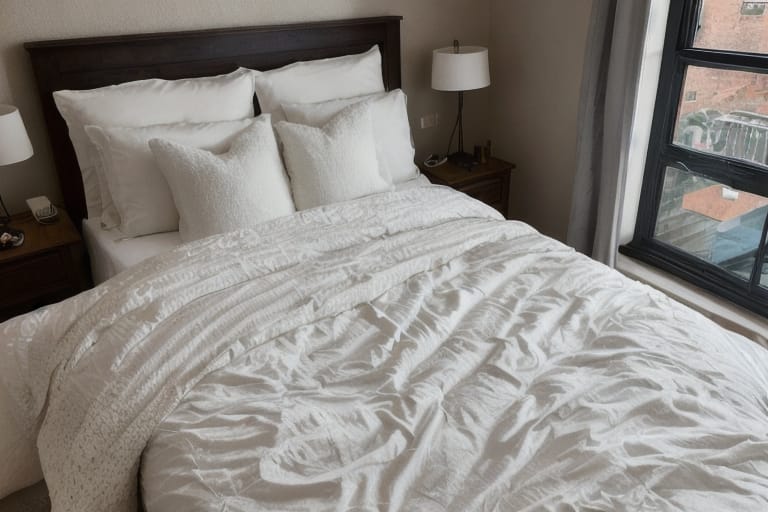
Frequently Asked Questions
- What is the difference between goose down and duck down in comforters? Goose down is generally considered to be of higher quality than duck down, as it has larger clusters and better loft. However, duck down can still provide excellent warmth and comfort at a lower price point.
- What is fill power and why does it matter in a down comforter? Fill power measures the loft and insulating ability of the down. The higher the fill power, the warmer and fluffier the comforter will be. Look for comforters with a fill power of at least 600 for optimal warmth and comfort.
- How do I choose the right size and fit for my down comforter? Make sure to measure your bed and select a comforter that is appropriately sized, allowing for plenty of drape over the sides. If you share a bed with a partner, consider an oversized comforter in a King or California King size for maximum coverage.
- What is the difference between baffle box and sewn-through construction in down comforters? Baffle box construction features vertical walls of fabric that separate the down filling into boxes, allowing it to loft fully and provide maximum insulation. Sewn-through construction, on the other hand, features the top and bottom layers of the comforter sewn together directly, creating a thinner, more lightweight design.
- How do I care for and maintain my down comforter to extend its lifespan? Most down comforters are machine washable, but it’s important to follow the manufacturer’s care instructions carefully. Use a mild detergent and wash on a gentle cycle with cold water. After washing, dry your comforter on low heat with a few clean tennis balls or dryer balls to help restore its loft and fluffiness. When not in use, store your comforter in a breathable storage bag to protect it from dust and moisture.
- Are there any sustainable and eco-friendly options for down comforters? Yes, there are several sustainable and eco-friendly options available. Look for comforters made with recycled materials, such as recycled down or recycled polyester shells, or natural materials like organic cotton, lyocell, or eucalyptus fibers. Choose brands that prioritize ethical manufacturing practices and responsible sourcing of down.
- What should I look for in a down comforter if I have allergies or sensitivities? If you have allergies or sensitivities, look for a down comforter with hypoallergenic down that has been treated to reduce allergens and irritants. Comforters with antimicrobial and moisture-wicking treatments can also be a good choice, as they help reduce the growth of bacteria and keep the comforter fresh and dry. Alternatively, consider a down-alternative comforter made with synthetic materials that mimic the feel of down without the potential for allergic reactions.

